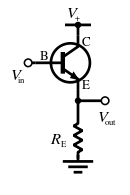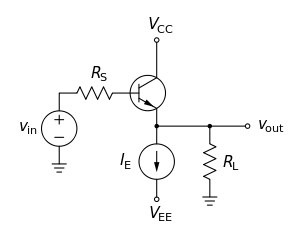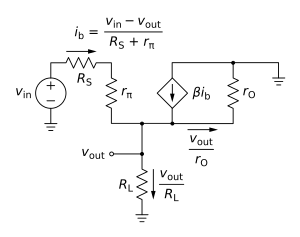Hyperfine structure: Difference between revisions
en>Csoliverez mNo edit summary |
en>Materialscientist m Reverted edits by 92.198.42.18 (talk) to last version by Mumiemonstret |
||
| Line 1: | Line 1: | ||
{{More footnotes|date=April 2009}} | |||
[[Image:NPN emitter follower.svg|right|thumb|130px|Figure 1: Basic NPN common collector circuit (neglecting [[biasing]] details).]] | |||
In [[electronics]], a '''common collector''' [[electronic amplifier|amplifier]] (also known as an '''emitter follower''') is one of three basic single-stage [[bipolar junction transistor]] (BJT) amplifier [[Electronic amplifier#Common terminal|topologies]], typically used as a [[buffer amplifier#Voltage buffer|voltage buffer]]. | |||
In this circuit the base terminal of the transistor serves as the input, the emitter is the output, and the collector is ''common'' to both (for example, it may be tied to [[ground (electricity)|ground reference]] or a [[power supply rail]]), hence its name. The analogous [[field-effect transistor]] circuit is the [[common drain]] amplifier. | |||
== Basic circuit == | |||
[[Image:Block Diagram for Feedback.svg|thumb|right|Figure 2: A [[negative feedback amplifier]]|250px|right]] | |||
The circuit can be explained by viewing the transistor as being under the control of negative feedback. From this viewpoint, a common collector stage (Fig. 1) is an amplifier with full series [[negative feedback amplifier#Feedback and amplifier type|negative feedback]]. In this configuration (Fig. 2 with β = 1), the entire output voltage V<sub>OUT</sub> is placed contrary and in series with the input voltage V<sub>IN</sub>. Thus the two voltages are subtracted according to [[Kirchhoff's_circuit_laws#Kirchhoff's_voltage_law_(KVL)|KVL]] (the subtractor from the function block diagram is implemented just by the input loop) and their difference Vdiff = V<sub>IN</sub> - V<sub>OUT</sub> is applied to the base-emitter junction. The transistor monitors continuously Vdiff and adjusts its emitter voltage almost equal (less V<sub>BEO</sub>) to the input voltage by passing the according collector current through the emitter resistor R<sub>E</sub>. As a result, the output voltage follows the input voltage variations from V<sub>BEO</sub> up to V<sub>+</sub>; hence the name, emitter follower. | |||
Intuitively, this behavior can be also understood by realizing that the base-emitter voltage in the bipolar transistor is very insensitive to bias changes, so any change in base voltage is transmitted (to good approximation) directly to the emitter. It depends slightly on various disturbances (transistor tolerances, temperature variations, load resistance, collector resistor if it is added, etc.) since the transistor reacts to these disturbances and restores the equilibrium. It never saturates even if the input voltage reaches the positive rail. | |||
The common collector circuit can be shown mathematically to have a [[gain#Voltage gain|voltage gain]] of almost unity: | |||
: <math> | |||
{A_\mathrm{v}} = {v_\mathrm{out} \over v_\mathrm{in}} \approx 1 | |||
</math> | |||
[[Image:PNP emitter follower.svg|thumb|130px|Figure 3: PNP version of the emitter follower circuit, all polarities are reversed.]] | |||
A small voltage change on the input terminal will be replicated at the output (depending slightly on the transistor's gain and the value of the [[load resistance]]; see gain formula below). This circuit is useful because it has a large [[input impedance]], so it will not load down the previous circuit: | |||
: <math> | |||
r_\mathrm{in} \approx \beta_0 R_\mathrm{E} | |||
</math> | |||
and a small [[output impedance]], so it can drive low-resistance loads: | |||
: <math> | |||
r_\mathrm{out} \approx {R_\mathrm{E}} \| {R_\mathrm{source} \over \beta_0} | |||
</math> | |||
Typically, the emitter resistor is significantly larger and can be removed from the equation: | |||
: <math> | |||
r_\mathrm{out} \approx {R_\mathrm{source} \over \beta_0} | |||
</math> | |||
== Applications == | |||
[[Image:Voltage follower.svg|thumb|302px|Figure 4: NPN voltage follower with [[current source]] biasing suitable for integrated circuits]] | |||
The low output impedance allows a source with a large [[output impedance]] to drive a small [[load impedance]]; it functions as a voltage [[Buffer amplifier|buffer]]. In other words, the circuit has current gain (which depends largely on the h<sub>FE</sub> of the transistor) instead of voltage gain. A small change to the input current results in much larger change in the output current supplied to the output load. | |||
One aspect of buffer action is transformation of impedances. For example, the [[Thévenin's theorem|Thévenin resistance]] of a combination of a voltage follower driven by a voltage source with high Thévenin resistance is reduced to only the output resistance of the voltage follower (a small resistance). That resistance reduction makes the combination a more ideal voltage source. Conversely, a voltage follower inserted between a small load resistance and a driving stage presents a large load to the driving stage—an advantage in coupling a voltage signal to a small load. | |||
This configuration is commonly used in the output stages of [[Class B amplifier|class-B]] and [[Class AB amplifier|class-AB]] amplifiers. The base circuit is modified to operate the transistor in class-B or AB mode. In [[Class A amplifier|class-A]] mode, sometimes an active [[current source]] is used instead of R<sub>E</sub> (Fig. 4) to improve linearity and/or efficiency.<ref name=Elliot>[http://sound.westhost.com/project10.htm Rod Elliot: ''20-watt class A power amplifier'']</ref> | |||
== Characteristics == | |||
At low frequencies and using a simplified [[hybrid-pi model]], the following [[small-signal model|small-signal]] characteristics can be derived. (Parameter <math>\beta=g_m r_{\pi}</math> and the [[Parallel (geometry)|parallel]] lines indicate [[Series and parallel circuits#Parallel circuits|components in parallel]].) | |||
{| class="wikitable" style="background:white;text-align:left" | |||
! !! Definition !! Expression !! Approximate expression !! Conditions | |||
|- | |||
! '''[[gain#Current gain|Current gain]]''' | |||
|<math> {A_\mathrm{i}} = {i_\mathrm{out} \over i_\mathrm{in}} </math> | |||
|<math> \beta_0 + 1 \ </math> | |||
|<math> \approx \beta_0 </math> | |||
|<math> \beta_0 \gg 1 </math> | |||
|- | |||
! '''[[gain#Voltage gain|Voltage gain]]''' | |||
|<math> {A_\mathrm{v}} = {v_\mathrm{out} \over v_\mathrm{in}} </math> | |||
|<math> {g_m R_\mathrm{E} \over g_m R_\mathrm{E} + 1} </math> | |||
|<math> \approx 1 </math> | |||
|<math> g_m R_\mathrm{E} \gg 1 </math> | |||
|- | |||
! '''[[Input resistance]]''' | |||
|<math> r_\mathrm{in} = \frac{v_\mathrm{in}}{i_\mathrm{in}}</math> | |||
|<math> r_\pi + (\beta_0 + 1) R_\mathrm{E}\ </math> | |||
|<math> \approx \beta_0 R_\mathrm{E} </math> | |||
|<math> (g_m R_\mathrm{E} \gg 1) \wedge (\beta_0 \gg 1) </math> | |||
|- | |||
! '''[[Output resistance]]''' | |||
|<math> r_\mathrm{out} = \frac{v_\mathrm{out}}{i_\mathrm{out}}</math> | |||
|<math> R_\mathrm{E} \parallel \left( {r_\pi + R_\mathrm{source} \over \beta_0 + 1} \right) </math> | |||
|<math> \approx {1 \over g_m} + {R_\mathrm{source} \over \beta_0}</math> | |||
|<math> (\beta_0 \gg 1) \wedge (r_\mathrm{in} \gg R_\mathrm{source})</math> | |||
|} | |||
Where <math>R_\mathrm{source} \ </math> is the [[Thévenin's theorem|Thévenin]] equivalent source resistance. | |||
===Derivations=== | |||
[[Image:Voltage follower small-signal.svg|thumb|300px|Figure 5: Small-signal circuit corresponding to Figure 3 using the hybrid-pi model for the bipolar transistor at frequencies low enough to ignore bipolar device capacitances]] | |||
[[Image:Voltage follower output resistance.svg|300px |thumb|Figure 6: Low-frequency small-signal circuit for bipolar voltage follower with test current at output for finding output resistance. Resistor <math>R_\mathrm{E} = R_\mathrm{L} \parallel r_\mathrm{O}</math>.]] | |||
Figure 5 shows a low-frequency hybrid-pi model for the circuit of Figure 3. Using [[Ohm's law]] various currents have been determined and these results are shown on the diagram. Applying Kirchhoff's current law at the emitter one finds: | |||
:<math>(\beta+1)\frac{v_\mathrm{in}-v_\mathrm{out}}{R_\mathrm{S}+r_{\pi}} = v_\mathrm{out}\left(\frac{1}{R_\mathrm{L}} + \frac{1}{r_\mathrm{O}}\right) \ . </math> | |||
Define the following resistance values: | |||
:<math> \frac{1}{R_\mathrm{E}} = \frac{1}{R_\mathrm{L}} + \frac{1}{r_\mathrm{O}} </math> | |||
:<math>R=\frac{R_\mathrm{S}+r_{\pi}}{\beta+1} \ . </math> | |||
Then collecting terms the voltage gain is found as: | |||
:<math>A_\mathrm{v} = \frac{v_\mathrm{out}}{v_\mathrm{in}} = \frac{1}{1+\frac{R}{R_\mathrm{E}}} \ . </math> | |||
From this result the gain approaches unity (as expected for a [[buffer amplifier]]) if the resistance ratio in the denominator is small. This ratio decreases with larger values of current gain β and with larger vales of <math>R_\mathrm{E}</math>. | |||
The input resistance is found as: | |||
:<math>R_\mathrm{in} = \frac{v_\mathrm{in}}{i_\mathrm{b}} = \frac{R_\mathrm{S}+r_{\pi}}{1-A_\mathrm{v}} \ </math> | |||
::<math>=\left(R_\mathrm{S}+r_{\pi}\right)\left(1+\frac{R_\mathrm{E}}{R}\right ) \ </math> | |||
::<math> = R_\mathrm{S}+r_{\pi} +(\beta+1)R_\mathrm{E} \ . </math> | |||
The transistor output resistance <math>r_\mathrm{O}</math> ordinarily is large compared to the load <math>R_\mathrm{L}</math> and therefore <math>R_\mathrm{L}</math> dominates <math>R_\mathrm{E}</math>. From this result, the input resistance of the amplifier is much larger than the output load resistance <math>R_\mathrm{L}</math> for large current gain <math>\beta</math>. That is, placing the amplifier between the load and the source presents a smaller (high-resistive) load to the source than direct coupling to <math>R_\mathrm{L}</math>, which results in less signal attenuation in the source impedance <math>R_\mathrm{S}</math> as a consequence of [[voltage division]]. | |||
Figure 6 shows the small-signal circuit of Figure 5 with the input short-circuited and a test current placed at its output. The output resistance is found using this circuit as: | |||
:<math> R_\mathrm{out} = \frac{v_\mathrm{x}}{i_\mathrm{x}} \ . </math> | |||
Using Ohm's law, various currents have been found, as indicated on the diagram. Collecting the terms for the base current, the base current is found as: | |||
:<math>(\beta+1)i_\mathrm{b} = i_\mathrm{x}-\frac{v_\mathrm{x}}{R_\mathrm{E}} \ , </math> | |||
where <math>R_\mathrm{E}</math> is defined above. Using this value for base current, Ohm's law provides <math>v_\mathrm{x}</math> as: | |||
:<math> v_\mathrm{x} = i_\mathrm{b} \left( R_\mathrm{S}+r_{\pi} \right) \ . </math> | |||
Substituting for the base current, and collecting terms, | |||
:<math> R_\mathrm{out} = \frac{v_\mathrm{x}}{i_\mathrm{x}} = R \parallel R_\mathrm{E} \ , </math> | |||
where || denotes a parallel connection and <math>R</math> is defined above. Because <math>R</math> generally is a small resistance when the current gain <math>\beta</math> is large, <math>R</math> dominates the output impedance which therefore also is small. A small output impedance means the series combination of the original voltage source and the voltage follower presents a [[Thévenin's theorem|Thévenin voltage source]] with a lower Thévenin resistance at its output node; that is, the combination of voltage source with voltage follower makes a more ideal voltage source than the original one. | |||
==See also== | |||
{{Portal|Electronics}} | |||
*[[Common base]] | |||
*[[Common emitter]] | |||
*[[Common gate]] | |||
*[[Common source]] | |||
*[[Open collector]] | |||
*[[Two-port network]] | |||
==References== | |||
{{Reflist}} | |||
==External links== | |||
* [http://people.deas.harvard.edu/~jones/es154/lectures/lecture_3/bjt_amps/bjt_amps.html R Victor Jones: ''Basic BJT Amplifier Configurations''] | |||
* [http://230nsc1.phy-astr.gsu.edu/hbase/electronic/npncc.html NPN Common Collector Amplifier] — [[HyperPhysics]] | |||
* [http://www.tedpavlic.com/teaching/osu/ece327/lab1_bjt/lab1_bjt_transistor_basics.pdf Theodore Pavlic: ECE 327: Transistor Basics; part 6: ''npn Emitter Follower''] | |||
*[http://www.phys.ualberta.ca/~gingrich/phys395/notes/node86.html Doug Gingrich: ''The common collector amplifier'' U of Alberta ] | |||
*[http://zebu.uoregon.edu/~rayfrey/431/lab3_431.pdf Raymond Frey: ''Lab exercises'' U of Oregon] | |||
{{Transistor amplifiers}} | |||
[[Category:Single-stage transistor amplifiers]] | |||
Revision as of 00:51, 31 January 2014

In electronics, a common collector amplifier (also known as an emitter follower) is one of three basic single-stage bipolar junction transistor (BJT) amplifier topologies, typically used as a voltage buffer.
In this circuit the base terminal of the transistor serves as the input, the emitter is the output, and the collector is common to both (for example, it may be tied to ground reference or a power supply rail), hence its name. The analogous field-effect transistor circuit is the common drain amplifier.
Basic circuit

The circuit can be explained by viewing the transistor as being under the control of negative feedback. From this viewpoint, a common collector stage (Fig. 1) is an amplifier with full series negative feedback. In this configuration (Fig. 2 with β = 1), the entire output voltage VOUT is placed contrary and in series with the input voltage VIN. Thus the two voltages are subtracted according to KVL (the subtractor from the function block diagram is implemented just by the input loop) and their difference Vdiff = VIN - VOUT is applied to the base-emitter junction. The transistor monitors continuously Vdiff and adjusts its emitter voltage almost equal (less VBEO) to the input voltage by passing the according collector current through the emitter resistor RE. As a result, the output voltage follows the input voltage variations from VBEO up to V+; hence the name, emitter follower.
Intuitively, this behavior can be also understood by realizing that the base-emitter voltage in the bipolar transistor is very insensitive to bias changes, so any change in base voltage is transmitted (to good approximation) directly to the emitter. It depends slightly on various disturbances (transistor tolerances, temperature variations, load resistance, collector resistor if it is added, etc.) since the transistor reacts to these disturbances and restores the equilibrium. It never saturates even if the input voltage reaches the positive rail.
The common collector circuit can be shown mathematically to have a voltage gain of almost unity:

A small voltage change on the input terminal will be replicated at the output (depending slightly on the transistor's gain and the value of the load resistance; see gain formula below). This circuit is useful because it has a large input impedance, so it will not load down the previous circuit:
and a small output impedance, so it can drive low-resistance loads:
Typically, the emitter resistor is significantly larger and can be removed from the equation:
Applications

The low output impedance allows a source with a large output impedance to drive a small load impedance; it functions as a voltage buffer. In other words, the circuit has current gain (which depends largely on the hFE of the transistor) instead of voltage gain. A small change to the input current results in much larger change in the output current supplied to the output load.
One aspect of buffer action is transformation of impedances. For example, the Thévenin resistance of a combination of a voltage follower driven by a voltage source with high Thévenin resistance is reduced to only the output resistance of the voltage follower (a small resistance). That resistance reduction makes the combination a more ideal voltage source. Conversely, a voltage follower inserted between a small load resistance and a driving stage presents a large load to the driving stage—an advantage in coupling a voltage signal to a small load.
This configuration is commonly used in the output stages of class-B and class-AB amplifiers. The base circuit is modified to operate the transistor in class-B or AB mode. In class-A mode, sometimes an active current source is used instead of RE (Fig. 4) to improve linearity and/or efficiency.[1]
Characteristics
At low frequencies and using a simplified hybrid-pi model, the following small-signal characteristics can be derived. (Parameter and the parallel lines indicate components in parallel.)
| Definition | Expression | Approximate expression | Conditions | |
|---|---|---|---|---|
| Current gain | ||||
| Voltage gain | ||||
| Input resistance | ||||
| Output resistance |
Where is the Thévenin equivalent source resistance.
Derivations


Figure 5 shows a low-frequency hybrid-pi model for the circuit of Figure 3. Using Ohm's law various currents have been determined and these results are shown on the diagram. Applying Kirchhoff's current law at the emitter one finds:
Define the following resistance values:
Then collecting terms the voltage gain is found as:
From this result the gain approaches unity (as expected for a buffer amplifier) if the resistance ratio in the denominator is small. This ratio decreases with larger values of current gain β and with larger vales of . The input resistance is found as:
The transistor output resistance ordinarily is large compared to the load and therefore dominates . From this result, the input resistance of the amplifier is much larger than the output load resistance for large current gain . That is, placing the amplifier between the load and the source presents a smaller (high-resistive) load to the source than direct coupling to , which results in less signal attenuation in the source impedance as a consequence of voltage division.
Figure 6 shows the small-signal circuit of Figure 5 with the input short-circuited and a test current placed at its output. The output resistance is found using this circuit as:
Using Ohm's law, various currents have been found, as indicated on the diagram. Collecting the terms for the base current, the base current is found as:
where is defined above. Using this value for base current, Ohm's law provides as:
Substituting for the base current, and collecting terms,
where || denotes a parallel connection and is defined above. Because generally is a small resistance when the current gain is large, dominates the output impedance which therefore also is small. A small output impedance means the series combination of the original voltage source and the voltage follower presents a Thévenin voltage source with a lower Thévenin resistance at its output node; that is, the combination of voltage source with voltage follower makes a more ideal voltage source than the original one.
See also
Sportspersons Hyslop from Nicolet, usually spends time with pastimes for example martial arts, property developers condominium in singapore singapore and hot rods. Maintains a trip site and has lots to write about after touring Gulf of Porto: Calanche of Piana.
References
43 year old Petroleum Engineer Harry from Deep River, usually spends time with hobbies and interests like renting movies, property developers in singapore new condominium and vehicle racing. Constantly enjoys going to destinations like Camino Real de Tierra Adentro.








































